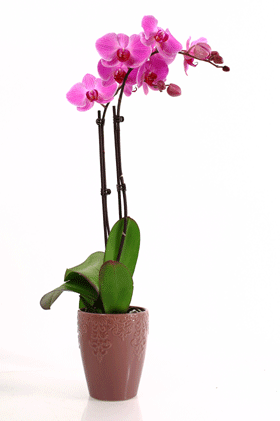 Many materials can be used to pot Phalaenopsis orchids as long as they provide proper drainage and root aeration. While orchid bark and sphagnum moss are the two most popular orchid potting materials in the U.S., they are usually mixed with a number of other materials to create commercial (or homemade) potting mixes.
Many materials can be used to pot Phalaenopsis orchids as long as they provide proper drainage and root aeration. While orchid bark and sphagnum moss are the two most popular orchid potting materials in the U.S., they are usually mixed with a number of other materials to create commercial (or homemade) potting mixes.
In our previous post, we talked about the most commonly used orchid-potting materials. Today, we review some of the more unusual ingredients that find their way into orchid potting mixes, albeit in small amounts:
- Coconut chunks, commonly used instead of bark in Asia where they are a plentiful and renewable resource, are making inroads in the U.S. but have gotten a mixed reception. While easy to use and offering the advantage of a five-year replacement life, their major drawbacks are expense and potentially high-sodium content, depending on their source. Salts can burn and leach moisture from orchid roots, endangering the plant. To avoid harming plants, check the product’s sodium content before using.
- Lava rock is often substituted for bark in Hawaii where lava is plentiful. It is generally added to commercial mixes as an auxiliary component in small amounts to aid aeration and drainage.
- Charcoal is added to potting mixes in small amounts to improve aeration. Many growers also believe it absorbs toxins from water and plant roots. Only use horticultural grade charcoal, never charcoal briquettes or wood charcoal.
- Among other materials added to potting mixes in small amounts are cork, peat moss, rockwool, clay pellets, and/or broken clay pot shards.
Much more information can be found on our Orchid Repotting Forum. For more tips on orchid potting, watch our video on orchid repotting.
 Many materials can be used to pot Phalaenopsis orchids as long as they provide proper drainage and root aeration. While orchid bark and sphagnum moss are the two most popular orchid potting materials in the U.S., they are usually mixed with a number of other materials to create commercial (or homemade) potting mixes.
Many materials can be used to pot Phalaenopsis orchids as long as they provide proper drainage and root aeration. While orchid bark and sphagnum moss are the two most popular orchid potting materials in the U.S., they are usually mixed with a number of other materials to create commercial (or homemade) potting mixes.